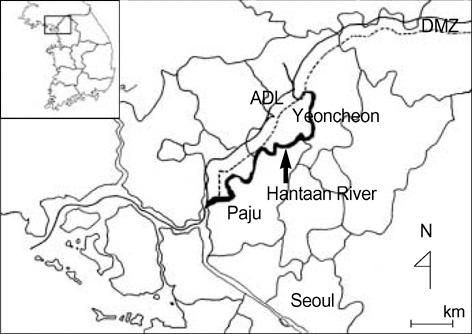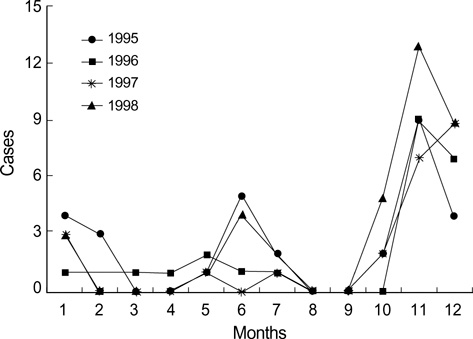J Korean Med Sci.
2006 Aug;21(4):614-620. 10.3346/jkms.2006.21.4.614.
Epidemiology of Hemorrhagic Fever with Renal Syndrome in Endemic Area of the Republic of Korea, 1995-1998
- Affiliations
-
- 1Division of Infectious Diseases, Department of Internal Medicine, Korea University, College of Medicine, Seoul, Korea. machropha@korea.ac.kr
- 2Research Institute of Emerging Infectious Diseases, Korea University, College of Medicine, Seoul, Korea.
- 3Department of Preventive Medicine, Korea University, College of Medicine, Seoul, Korea.
- 4Department of Microbiology, Korea University, College of Medicine, Seoul, Korea.
- 5Korean Armed Forces Daegu Hospital, Daegu, Korea.
- KMID: 2157810
- DOI: http://doi.org/10.3346/jkms.2006.21.4.614
Abstract
- We conducted an epidemiologic study to understand temporal and spatial patterns of hemorrhagic fever with renal syndrome (HFRS) in the Republic of Korea (ROK). We estimated the incidence among civilians in endemic areas through the active surveillance system during the major epidemic periods, from September to December, between 1996 and 1998. We also estimated the prevalence among Korean military personnel from 1995 to 1998. In addition, we assessed seroprevalence, subclinical infection rate, and vaccination rates in both civilians and military personnel. The incidence in civilians ranged from 2.1 to 6.6 per 100, 000 person-months. The annual prevalence in the military personnel was 40-64 per 100, 000 military populations, and remained generally constant throughout the study period with seasonal variation. This is the prospective epidemiologic data set on HFRS in the ROK since the inactivated Hantaan virus vaccine was licensed for use in the late 1990s. These results will be invaluable in establishing a national immunization program against HFRS.
Keyword
MeSH Terms
Figure
Cited by 2 articles
-
Hemorrhagic Fever with Renal Syndrome
Hyo Youl Kim
Infect Chemother. 2009;41(6):323-332. doi: 10.3947/ic.2009.41.6.323.Absence of a Seasonal Variation of Hemorrhagic Fever with Renal Syndrome in Yeoncheon Compared to Nationwide Korea
Yo Han Park
Infect Chemother. 2018;50(2):120-127. doi: 10.3947/ic.2018.50.2.120.
Reference
-
1. Schmaljohn CS, Hasty SE, Dalrymple JM, LeDuc JW, Lee HW. Antigenic and genetic properties of viruses linked to hemorrhagic fever with renal syndrome. Science. 1985. 227:1041–1044.
Article2. LeDuc JW. Epidemiology of Hantaan and related viruses. Lab Anim Sci. 1987. 37:413–418.3. Lee HW, van der Groen G. Hemorrhagic fever with renal syndrome. Prog Med Virol. 1989. 36:62–102.4. Tsai TF. Hemorrhagic fever with renal syndrome: mode of transmission to humans. Lab Anim Sci. 1987. 37:428–430.5. Lee HW, Lee PW, Johnson KM. Isolation of the etiologic agent of Korean hemorrhagic fever. 1978. J Infect Dis. 2004. 190:1711–1721.6. Lee HW, Johnson KM. Laboratory-acquired infections with Hantaan virus, the etiologic agent of Korean hemorrhagic fever. J Infect Dis. 1982. 146:645–651.
Article7. Lee JS. Clinical feature of hemorrhagic fever with renal syndrome in Korea. Kidney Int. 1991. 40:Suppl 35. 88–93.8. Lee JS. Lee HW, Calisher C, Schmaljohn CS, editors. . Clinical manifestations and treatment of HFRS and HPS. Manual of hemorrhagic fever with renal syndrome and hantavirus pulmonary syndrome. 1999. Seoul: WHO Collaborating Center for Virus Reference and Research (Hantaviruses) Asan Institute for Life Science;18–27.9. Lee HW. Hemorrhagic fever with renal syndrome in Korea. Rev Infect Dis. 1989. 11:Suppl 4. 864–876.
Article10. Smadel JE. Epidemic hemorrhagic fever. Am J Public Health. 1953. 43:1327–1330.
Article11. Lee HW, Lee PW. Korean hemorrhagic fever 1, demonstration of causative antigen and antibodies. Korean J Intern Med. 1976. 19:371–383.12. Hwang YJ, Park JH, Yeh MH, Dixon KE. A case-control study of risk factors for hemorrhagic fever with renal syndrome. Korean J Epidemiol. 1994. 16:41–53.13. Yang CW, Jang DH, Cho YH. Epidemiologic study of hemorrhagic fever with renal syndrome in Korean military: 1985-1990. Korean J Intern Med. 1987. 42:802–808.14. Lee M. Hemorrhagic fever with renal syndrome (Korean hemorrhagic fever). Rinsho Ketsueki. 1987. 28:496–504.15. Korea Center for Disease Control and Prevention (KCDC). Recent trends in notifiable disease occurrence based on the data of 2003. Communicable Disease Monthly Report, Korea. 2004. 15:130–151.16. Lee HW, Kwon EH, Park SC, Cheong HJ, Kim WJ, Jeong EK. Policy on vaccine and vaccination in Korea. J Nat Academy Science. 1999. 38:1–75.17. Sohn YM, Rho HO, Park MS, Kim JS, Summers PL. Primary humoral immune responses to formalin inactivated hemorrhagic fever with renal syndrome vaccine (Hantavax): consideration of active immunization in South Korea. Yonsei Med J. 2001. 42:278–284.
Article18. Park KH, Kim CS, Moon KT. Protective effectiveness of hantavirus vaccine. Emerg Infect Dis. 2004. 10:2218–2220.
Article19. Cho HW, Howard CR, Lee HW. Review of an inactivated vaccine against hantaviruses. Intervirology. 2002. 45:328–333.
Article20. Lee M. Lee M, editor. Epidemiology. Korean hemorrhagic fever (Hemorrhagic fever with renal syndrome). 1986. Seoul: Seoul National University Press;27–48.21. Niklasson B. Lee HW, Calisher C, Schmaljohn CS, editors. Virus detection and identification with serological test. Manual of hemorrhagic fever with renal syndrome and hantavirus pulmonary syndrome. 1999. Seoul: WHO Collaborating Center for Virus Reference and Research (Hantaviruses) Asan Institute for Life Science;80–121.22. Baek LJ, Song JW, Song KJ. Seroepizoonotiology of Hantavirus infection in indigenous rodents in Korea, during 1995-2000. J Microbiol Biotechnol. 2002. 12:53–58.23. Song G. Epidemiological progresses of hemorrhagic fever with renal syndrome in China. Chin Med J. 1999. 112:472–477.24. Ruo SL, Li YL, Tong Z, Ma QR, Liu ZL, Tang YW, Ye KL, McCormick JB, Fisher-Hoch SP, Xu ZY. Retrospective and prospective studies of hemorrhagic fever with renal syndrome in rural China. J Infect Dis. 1994. 170:527–534.
Article25. Kao CL, Chen CJ, Yen TS, Lien JC, Yang CS. Seroepidemiology of Hantaan virus infection in Taiwan. J Med Virol. 1996. 50:309–313.
Article
- Full Text Links
- Actions
-
Cited
- CITED
-
- Close
- Share
- Similar articles
-
- Epidemic Hemorrhagic Fever in Korea
- Hemorrhagic Fever with Renal Syndrome Complicated with Pregnancy: A Case Report
- Hemorrhagic Fever with Renal Syndrome
- A Case of Hemorrhagic Fever with Renal Syndrome with Stress-induced Cardiomyopathy
- Hemorrhagic fever with renal syndrome and coexisting hantavirus pulmonary syndrome




